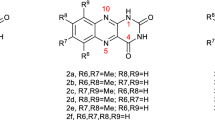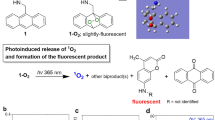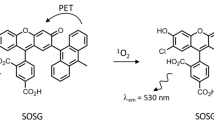Abstract
SINGLET molecular oxygen is a very powerful oxidant. Its action is important in a variety of chemical and biological processes1–4, for examples dye-sensitised photooxidation of lipids, proteins and nucleic acids4, photodynamic inactivation of viruses5 and cells4, phototherapy of cancer6,7, carcinogenesis8, haemolysis of erythocytes9, sensitisation of the human skin4 and degradation of food4. The methods used to detect singlet oxygen are unspecific, of low sensitivity or laborious. Photooxidation of 1,3-diphenylisobenzofuran seems to be the most widely used diagnostic test for 1O2. However, in the absence of additional control experiments this test does not prove the intermediacy of 1O2 (ref. 4) and 1,3-diphenylisobenzofuran has very low solubility and dimerises in aqueous solutions. Lion et al.10 have proposed a new method to detect 1O2 involving the generation of stable nitroxide radicals when 1O2 reacts with the sterically hindered amine 2,2,6,6,-tetramethylpiperidin. When using this method to detect 1O2 in neutral aqueous solutions, we found no radical production. We report here our investigation of this problem, as it is biologically important to be able to detect 1O2 production in such solutions.
This is a preview of subscription content, access via your institution
Access options
Subscribe to this journal
Receive 51 print issues and online access
$199.00 per year
only $3.90 per issue
Buy this article
- Purchase on Springer Link
- Instant access to full article PDF
Prices may be subject to local taxes which are calculated during checkout
Similar content being viewed by others
References
Kearns, D. R. Chem. Rev. 71, 395–427 (1971).
Khan, A. U. J. phys. Chem. 80, 2219–2227 (1976).
Rosenthal, I. Photochem. Photobiol. 24, 641–645 (1976).
Spikes, J. D. in The Science of Photobiology (ed. Smith, K. C.) 87–112 (Plenum, New York, 1977).
Wallis, C. & Melnick, J. L. Photochem. Photobiol. 4, 159–170 (1965).
Granelli, S., Diamond, I., McDonagh, A., Wilson, C. & Nielsen, S. Cancer Res. 35, 2567–2570 (1975).
Dougherty, T. J., Grindey, G., Fiel, R., Weishaupt, K. & Boyle, D. J. natn. Cancer Inst. 55, 115–121 (1975).
Foote, C. S. in Free Radicals in Biology (ed. Pryor, W. A.) 85–133 (Academic, New York, 1976).
Goldstein, B. D. & Harber, L. C. J. clin. Invest. 51, 892–902 (1972).
Lion, Y., Delmelle, M. & Van de Vorst, A., Nature 263, 442–443 (1976).
Weishaupt, K. R., Gomer, C. J. & Dougherty, T. J. Cancer Res. 36, 2326–2329 (1976).
Moan, J., Pettersen, E. O. & Christensen, T. Br. J. Cancer (in the press).
Rozantsev, E. G. Free Nitroxyl Radicals, 213–214 (Plenum, New York, 1970).
Merkel, P. B. & Kearns, D. R. J. Am. chem. Soc. 94, 7244–7352 (1972).
Dougherty, T. J. et al. Cancer Res. 38, 2628–2635 (1978).
Author information
Authors and Affiliations
Rights and permissions
About this article
Cite this article
MOAN, J., WOLD, E. Detection of singlet oxygen production by ESR. Nature 279, 450–451 (1979). https://doi.org/10.1038/279450a0
Received:
Accepted:
Published:
Issue Date:
DOI: https://doi.org/10.1038/279450a0
This article is cited by
-
Mn-single-atom nano-multizyme enabled NIR-II photoacoustically monitored, photothermally enhanced ROS storm for combined cancer therapy
Biomaterials Research (2023)
-
Oxidative degradation of sulfamethoxazole antibiotic catalyzed by porous magnetic manganese ferrite nanoparticles: mechanism and by-products identification
Journal of Materials Science (2020)
-
Cryodesiccation-driven crystallization preparation approach for zinc(II)-phthalocyanine nanodots in cancer photodynamic therapy and photoacoustic imaging
Microchimica Acta (2019)
-
Cooperative supramolecular polymers with anthracene‒endoperoxide photo-switching for fluorescent anti-counterfeiting
Nature Communications (2018)
-
Protoporphyrin IX conjugated bacterial cellulose via diamide spacer arms with specific antibacterial photodynamic inactivation against Escherichia coli
Cellulose (2018)
Comments
By submitting a comment you agree to abide by our Terms and Community Guidelines. If you find something abusive or that does not comply with our terms or guidelines please flag it as inappropriate.



